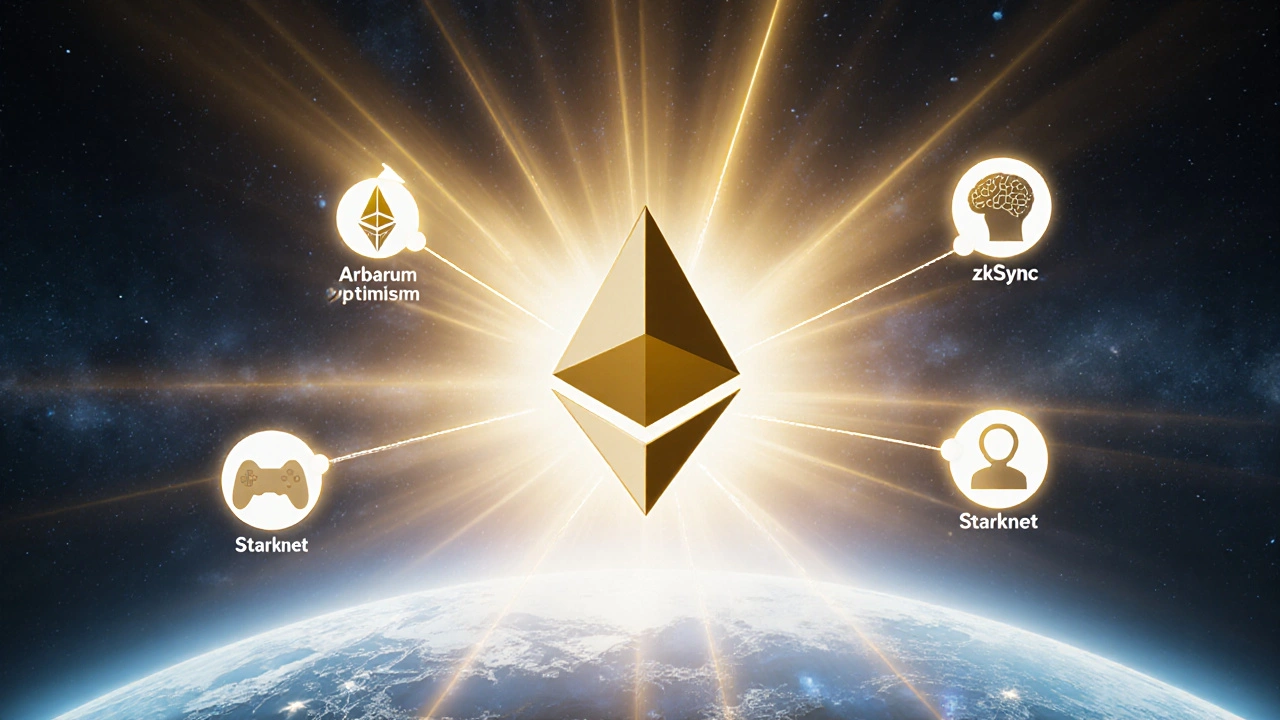Ethereum is slow and expensive. You’ve probably felt it-waiting minutes for a transaction to confirm, or paying $50 just to swap tokens. That’s not how it was supposed to be. Ethereum was built to be a global, decentralized computer. But as more people used it, the network got clogged. Enter L2 networks: the fix that’s already changing how Ethereum works.
Why Ethereum Needs Layer 2
Ethereum’s main chain, called Layer 1 or L1, handles every transaction, smart contract, and NFT mint. That sounds great in theory. In practice, it’s like putting every delivery truck on a single two-lane road. When demand spikes-like during an NFT drop or a DeFi surge-gas fees skyrocket and transactions stall.
Back in 2021, average gas fees hit over $70. Even now, simple swaps can cost $5-$15. That’s fine if you’re a hedge fund. Not fine if you’re sending $20 to a friend or buying a digital collectible. Ethereum’s developers knew this. They didn’t try to make the main chain faster-they built side roads.
That’s where Layer 2 comes in. L2 networks are separate blockchains built on top of Ethereum. They handle transactions off the main chain, then bundle them up and post a single proof back to Ethereum. Think of it like taking 100 grocery trips and turning them into one big delivery. Ethereum only needs to verify the final receipt, not every item you bought.
How L2 Networks Work
L2 networks don’t replace Ethereum. They depend on it. Every L2 uses Ethereum as its security backbone. If something goes wrong on an L2, you can still get your funds back using Ethereum’s rules.
There are two main types of L2s: Optimistic Rollups and Zero-Knowledge Rollups (ZK-Rollups). Both do the same thing-move transactions off-chain-but they prove it differently.
Optimistic Rollups assume everything is honest unless someone challenges it. They wait 7 days for someone to spot fraud. If no one does, the transaction is final. This is slower to finalize but cheaper to build. Projects like Arbitrum and Optimism use this method.
ZK-Rollups use math to prove transactions are valid right away. They generate a cryptographic proof (called a zk-SNARK) that says, “These 1,000 transactions are correct.” Ethereum checks the proof in seconds. This is faster and more secure, but harder to code. Starknet and zkSync are leading ZK-Rollups.
Both types cut costs by 90-99%. On Arbitrum, a token swap costs less than $0.10. On zkSync, it’s often under $0.05. That’s not a small improvement-it’s a game-changer for everyday users.
Real-World Use Cases
L2s aren’t just theory. They’re running real apps with real money.
Uniswap, the biggest decentralized exchange, moved its main trading volume to Arbitrum and Optimism. Over 80% of its trades now happen on L2s. Users aren’t just saving money-they’re trading more often because it’s affordable.
Gaming is another big winner. Games like Immutable X (a ZK-Rollup) let players trade NFTs instantly with near-zero fees. You can buy, sell, or equip a digital sword without paying $20 in gas. That’s what made Web3 gaming finally feel playable.
Even payments are shifting. Apps like Argent and Circle’s USDC on L2s let people send dollars across borders in seconds for pennies. In countries with unstable currencies, this isn’t a luxury-it’s a lifeline.
Top L2 Networks Today
Not all L2s are the same. Here’s what’s leading the pack as of 2025:
| Network | Type | Transaction Cost (Avg) | Finality Time | Key Use Cases |
|---|---|---|---|---|
| Arbitrum | Optimistic Rollup | $0.05-$0.15 | 7 days (fraud window) | DeFi, DEXs, general apps |
| Optimism | Optimistic Rollup | $0.03-$0.10 | 7 days (fraud window) | DeFi, token bridges, institutional apps |
| zkSync Era | ZK-Rollup | $0.01-$0.05 | Under 1 minute | Payments, gaming, privacy-focused apps |
| Starknet | ZK-Rollup | $0.02-$0.08 | Under 1 minute | AI + blockchain, complex smart contracts |
| Base | Optimistic Rollup | $0.01-$0.07 | 7 days (fraud window) | Onboarding new users, Coinbase ecosystem |
Base, built by Coinbase, is growing fast because it’s easy for beginners. Starknet is attracting developers who want to build AI agents on blockchain. zkSync is the favorite for payments because of its speed and low cost. Arbitrum and Optimism still lead in total value locked (TVL)-over $15 billion combined.
What You Can Do Today
You don’t need to be a developer to use L2s. Here’s how to start:
- Use a wallet that supports L2s-like MetaMask, Argent, or Coinbase Wallet.
- Bridge some ETH from Ethereum mainnet to your chosen L2. Most wallets have a built-in bridge.
- Once you’re on the L2, you’ll see lower fees and faster confirmations.
- Try swapping tokens, staking, or playing a game on the L2.
Don’t keep all your funds on an L2. Always keep a backup on Ethereum mainnet. L2s are safe, but they’re still new. If you’re moving large amounts, use trusted bridges like the official ones from Arbitrum or Optimism.

The Bigger Picture
L2s aren’t just about saving money. They’re about making Ethereum usable at scale. Before L2s, Ethereum felt like a luxury. Now, it’s becoming a utility-like electricity or the internet.
By 2026, over 80% of Ethereum activity is expected to happen on Layer 2s. That’s not a prediction-it’s already happening. Developers are building faster, cheaper, and more powerful apps because they don’t have to worry about Ethereum’s congestion.
The future isn’t about Ethereum becoming faster. It’s about Ethereum becoming the secure foundation for thousands of faster blockchains. L2s turned a bottleneck into a launchpad.
What’s Next?
Next up: L3s. Some teams are building Layer 3 networks on top of L2s-for even more speed and customization. Imagine a gaming L3 on zkSync, or a privacy-focused L3 on Arbitrum. It’s still early, but the architecture is there.
For now, L2s are the answer. They fixed Ethereum’s biggest problem without breaking its security. And that’s rare in crypto. Most solutions trade safety for speed. L2s gave us both.
Are L2 networks safe?
Yes, as long as you use trusted networks like Arbitrum, Optimism, zkSync, or Starknet. They all inherit Ethereum’s security. Even if the L2 has a bug, you can always withdraw your funds back to Ethereum. Never use unknown or unverified bridges.
Do I need to pay gas fees on L2s?
You still pay gas, but it’s a fraction of what you’d pay on Ethereum mainnet. Most L2s charge less than $0.10 per transaction. Some even offer free transactions for small swaps through sponsorship programs.
Can I use DeFi on L2s?
Absolutely. Most major DeFi platforms-Uniswap, Aave, Curve-now run primarily on L2s. You’ll get lower fees, faster trades, and better liquidity. In fact, many DeFi apps now offer higher yields on L2s because they attract more users.
What’s the difference between L2 and sidechains like Polygon?
Polygon is a sidechain-it has its own security and validators. L2s like Arbitrum or zkSync use Ethereum’s security. If Polygon’s network gets hacked, your funds could be lost. On an L2, even if the L2 fails, Ethereum can still protect your assets. That’s why L2s are considered more secure.
Will Ethereum mainnet become obsolete?
No. Ethereum mainnet will always be the settlement layer. It’s where L2s post their proofs and where users withdraw funds. Think of it as the bank vault. L2s are the ATMs-fast and convenient, but they still rely on the vault for safety.
Final Thoughts
If you’ve been holding off on Ethereum because of high fees, now’s the time to try again. L2 networks made Ethereum usable for normal people. You don’t need to be a crypto expert. Just move a small amount, test it out, and see the difference. The future of decentralized apps isn’t on Layer 1-it’s already here on Layer 2.


Buddy Faith
November 7, 2025 AT 07:16Scott Perlman
November 8, 2025 AT 19:31Sandi Johnson
November 10, 2025 AT 03:23Eva Monhaut
November 12, 2025 AT 00:20mark nine
November 12, 2025 AT 03:32Tony Smith
November 13, 2025 AT 09:04Rakesh Kumar
November 13, 2025 AT 17:20Bill Castanier
November 14, 2025 AT 02:44Ronnie Kaye
November 15, 2025 AT 14:51Priyank Panchal
November 16, 2025 AT 17:42